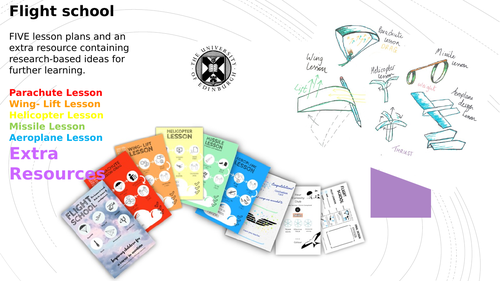





This resource is a the first of a set of five lesson plans with STEM activities based around a group of 10-12 year olds, wanting to get their ‘wings’ from Flight School, by completing activities on forces associated with flight.
This first session teaches the FORCE DRAG.
Other sessions involve LIFT, THRUST, WEIGHT), and the fifth AEROPLANE pulls together all the learning. The sixth section contains the learner self-evaluation and learning log which has also been included in this bundle.
This is the first on the force drag.
By the end of the lesson the goal is that students will have a clear understanding of drag and how the parachute causes a falling object to slow down, they will also be able to show their understanding in the log book that records their learning by labelling the arrows representing drag in the ‘Parachute section.’
This bundle includes: extensive teacher notes bundle includes pdf and editable versions of the following:
• Teaching Notes - contents for each lesson includes:
• Science behind the lesson
• Materials best for the session
• Parachute shapes
• Plenary responses
• List of resources specific for this lesson.
Main Lesson Plan (as a PowerPoint Resource)
• Learning goals
• Overview
• Set Up
• Task
• Plenary and Feedback
Flight School has been created as a teaching resource for the City of Edinburgh Council’s ‘Curiosity Club’, an Intervention Strategy initiative that is currently operating in Council schools.
A learner self-evaluation and learning log makes up the sixth section and this has been added to each section for ease of use.
Learning outcomes in the Curriculum for Excellence and associated benchmark
SCN 2-07a: By investigating how friction, including air resistance, affects motion, I can suggest ways to improve efficiency in moving objects.
TCH 2-04a: I am developing dexterity, creativity and confidence when preparing models
TCH 2-09a: I can extend and enhance my design skills to solve problems and can construct models.
TCH 2-10a: I can recognise basic properties and uses for a variety of materials and can discuss which ones are most suitable for a given task.
MNU 2:11b: I can use the common units of measure, convert between related units of the metric system and carry out calculations when solving problems.
To find more Open Educational Resources from the University of Edinburgh, visit open.ed.ac.uk.
Author: Joanna Barrie, adapted by Kay Douglas and Charlie Farley.
Unless otherwise stated, all content is released under a CC-BY-SA 4.0 license.
Something went wrong, please try again later.
This resource hasn't been reviewed yet
To ensure quality for our reviews, only customers who have downloaded this resource can review it
Report this resourceto let us know if it violates our terms and conditions.
Our customer service team will review your report and will be in touch.